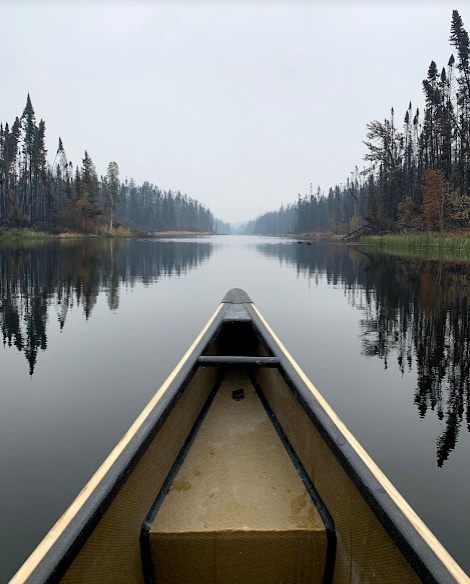Last summer I had the pleasure of participating in a 6-day canoe trip around the Otter Lake area, north of La Ronge. Packed, practiced, and feeling ready, we set out, blissfully unaware of what was to come. Throughout our first day of paddling we put out a dozen campfire-sized fires with our bailing buckets at our lunch spots and portages, jokingly referring to ourselves as “hobby firefighters.” After a relaxing evening of supper and conversation on the shore, things became tense as we started eyeing the smaller fires that had popped up on the island across from ours, only 200 meters away.
Suddenly, one tree went up in flames, then another and another. At 9:30 p.m., we saw the island beside us become engulfed. By 10 p.m. our entire camp site was packed and we began paddling to the next campsite, 18km away. After portaging through a burning landscape, which claimed one of our paddles and the skin on someone’s foot, we canoed through the night to get to our next campsite. We arrived at 4 a.m. in an area that thankfully had not been burned and was not at high risk.
As a student of Environmental Studies and Sociology, I have learned a lot about the impacts of natural disasters such as forest fires, although I never expected to get as up-close and personal as I did last summer. As a case study, let’s examine how forest fires impact the ways we engage in recreation currently.

The most obvious impact that fires have is their ability to destroy our physical environment, from outdoor environments such as hiking trails and fields to indoor facilities such as rinks or fieldhouses. As well, given the distance that smoke from forest fires can travel, air quality across the province can decrease to dangerous levels regardless of their distance from the fire itself. While risky for everyone, outdoor recreation in smoky conditions can be especially dangerous for young children, seniors, those who live with a disability, and those with pre-existing conditions. This will increase demand for indoor recreation facilities with suitable heating, cooling, and air filtration systems that communities may not have the ability to meet. This is not an exhaustive list, and I encourage you to think about how forest fires may impact your community, as every community has their own individual services and needs.
Forest fires and other natural disasters are among the most well-known effects of climate change. However, future impacts are not limited to extreme singular or episodic disasters that receive media attention. More examples of climate change’s impact on recreation and parks include:
- Difficulty maintaining playing surfaces such as grass or ice;
- A decrease in snowfall for winter recreational activities (such as skiing, sledding, snowshoeing);
- Hotter summers and dangerous cold snaps keeping people inside;
- An increased risk of heat stroke or frostbite;
- An increase in anxiety around nature, especially after a disaster;
- Shifting seasons changing schedules for facilities (open when the conditions aren’t right, closed when they are);
- Increased temperature variability causes freeze-thaw cycles that can make conditions dangerous; and
- A reduced population of animals available for hunting and fishing or changing species available as they move to new areas.
Changes due to climate change are not tomorrow’s problem. They are already threatening us today and solutions must be implemented with urgency.
While much of the activism surrounding climate change revolves around climate mitigation, climate adaptation is equally important. Climate adaptation is a discussion of how communities can and must change now to be safe and sustainable in the face of large-scale environmental changes. The recreation industry will not be immune to the threat of climate change and therefore discussions must be had about how we can ensure recreation remains both safe and accessible.

Here are some amazing resources that are helpful for starting the conversation about how your community or organization can be resilient to changing conditions:
- The Effects of Climate Change on Recreation and Tourism in the Prairies by the International Institute for Sustainable Development is especially applicable in Saskatchewan. It includes helpful diagrams on the outdoor conditions necessary for certain recreation activities that can help you judge what your community has to offer and how that might change in the future.
- Sports at risk: Addressing climate change in the Canadian sport sector by the Sport Ecology Group (an international nonprofit of academics working to accelerate climate action in the sport sector), is an easy-to-read article that lays out risks that your community may face. It introduces a “Sport for Climate Action” framework, a list of principles and practices that can help your community prepare for a changing future.
- Climate Change Adaptation Strategies and Approaches for Outdoor Recreation was developed by researchers from the USDA Forest Service, the Northern Institute of Applied Climate Science, and the College of Forest Resources and Environmental Science at the Michigan Technological University. This document lays down specific practices and approaches that your community can take to lower various risk factors. It is important to note that this is a document written for the US recreation industry, but it is still applicable to Canadian recreation practitioners.
I encourage you to take a moment for personal reflection and education on climate change and its effects on recreation by checking out these links of interest:
If you want to discuss more about climate adaptation, you can email me at
ssherk@spra.sk.ca and I can direct you to resources that tackle more specific needs in your community.



